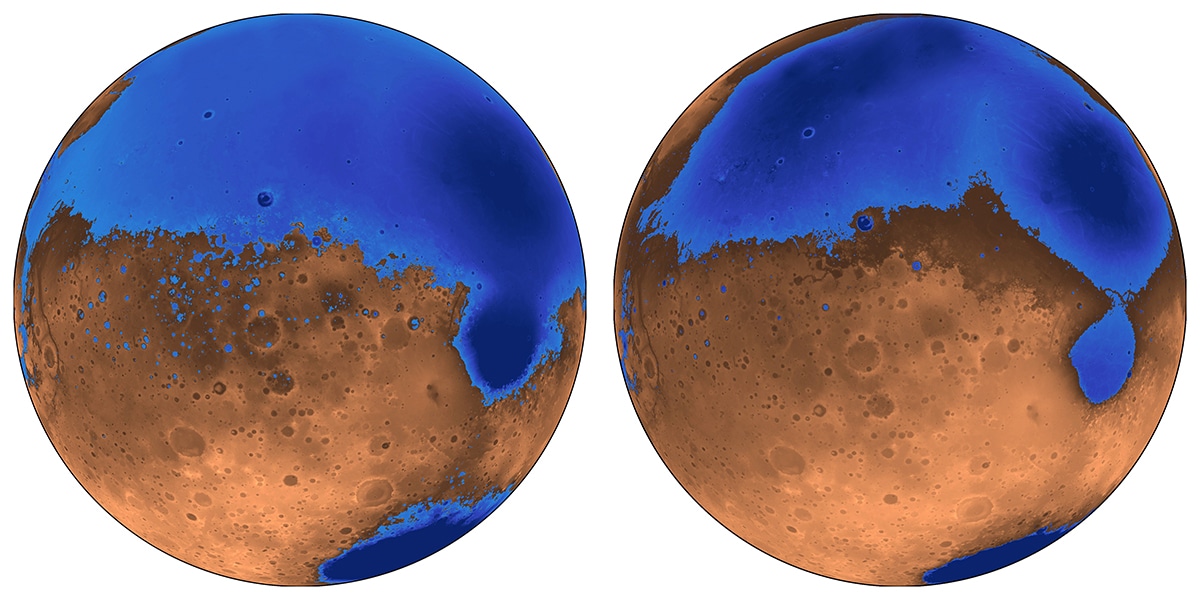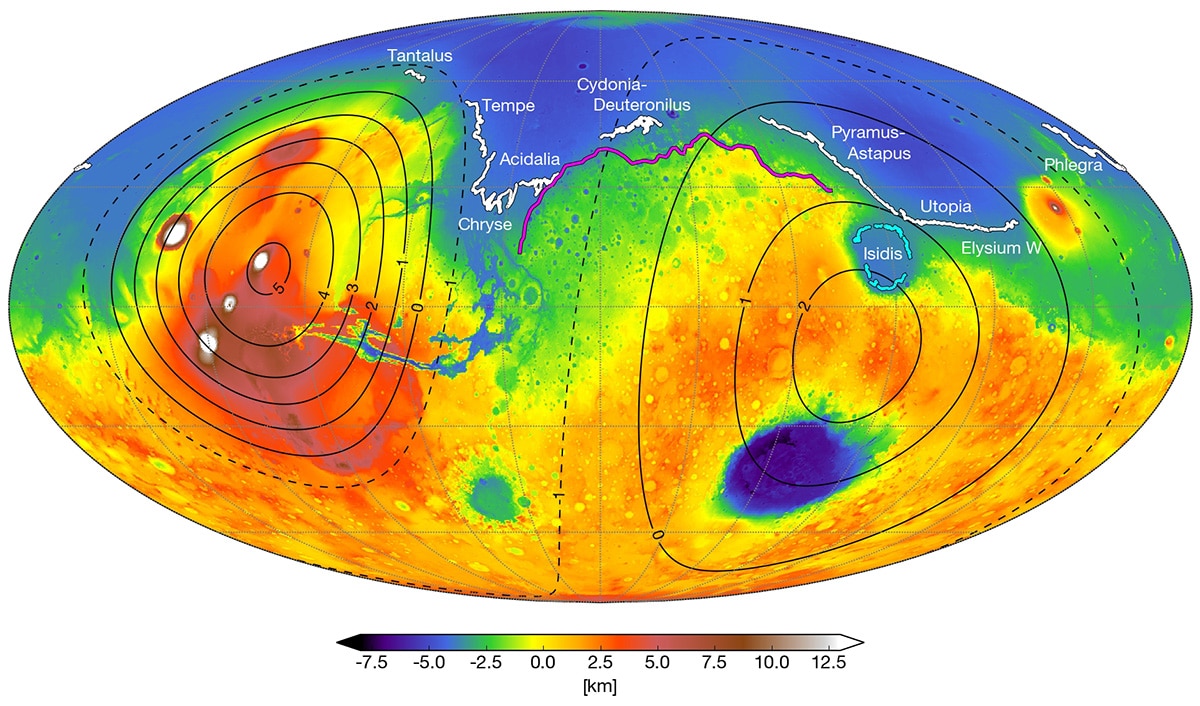A new theory of how oceans on Mars came and went over the last 4 billion years suggests they formed several hundred million years earlier and were not as deep as once thought.
The proposal links the existence of oceans early in Mars’ history to the rise of the solar system’s largest volcanic system, Tharsis, and highlights global warming’s key role in allowing liquid water to exist on the red planet.
“Volcanoes may be important in creating the conditions for Mars to be wet,” says Michael Manga, professor of earth and planetary science at the University of California, Berkeley, and senior author of a paper in Nature.

Theories claiming that Mars never had oceans of liquid water often point to the fact that estimates of the size of the oceans don’t jibe with estimates of how much water could be hidden today as permafrost underground and how much could have escaped into space. These are the main options, given that the polar ice caps don’t contain enough water to fill an ocean.
The new model proposes that the oceans formed before or at the same time as Mars’ largest volcanic feature, Tharsis, instead of after the volcanic system formed 3.7 billion years ago.
Because Tharsis was smaller at that time, it didn’t distort the planet as much as it did later, in particular the plains that cover most of the northern hemisphere and are the presumed ancient seabed.
The absence of crustal deformation from Tharsis means the seas would have been shallower, holding about half the water of earlier estimates.
“The assumption was that Tharsis formed quickly and early, rather than gradually, and that the oceans came later,” Manga says. “We’re saying that the oceans predate and accompany the lava outpourings that made Tharsis.”
It’s likely that Tharsis spewed gases into the atmosphere that created a global warming or greenhouse effect that allowed liquid water to exist on the planet, and also that volcanic eruptions created channels that allowed underground water to reach the surface and fill the northern plains.

Follow the shorelines
The model also counters another argument against oceans: that the proposed shorelines are irregular, varying in height by as much as a kilometer, when they should be level, like shorelines on Earth.
This irregularity could be explained if the first ocean, called Arabia, started forming about 4 billion years ago and existed, if intermittently, during as much as the first 20 percent of Tharsis’s growth. The growing volcano would have depressed the land and deformed the shoreline over time, which could explain the irregular heights of the Arabia shoreline.
Similarly, the irregular shoreline of a subsequent ocean, called Deuteronilus, could be explained if it formed during the last 17 percent of Tharsis’s growth, about 3.6 billion years ago.
“These shorelines could have been emplaced by a large body of liquid water that existed before and during the emplacement of Tharsis, instead of afterwards,” says first author Robert Citron, a UC Berkeley graduate student. Citron will present a paper about the new analysis at the annual Lunar and Planetary Science conference in Texas.
Flowing sand, not water, left dark streaks on Mars
Tharsis, now a 5,000-kilometer-wide eruptive complex, contains some of the biggest volcanoes in the solar system and dominates the topography of Mars. Earth, twice the diameter and 10 times more massive than Mars, has no equivalent dominating feature. Tharsis’s bulk creates a bulge on the opposite side of the planet and a depression halfway between. This explains why estimates of the volume of water the northern plains could hold based on today’s topography are twice what the new study estimates based on the topography 4 billion years ago.
Can the hypothesis hold up?
Manga, who models the internal heat flow of Mars, such as the rising plumes of molten rock that erupt into volcanoes at the surface, tried to explain the irregular shorelines of the plains of Mars 11 years ago with another theory. He and former graduate student Taylor Perron suggested that Tharsis, which was then thought to have originated at far northern latitudes, was so massive that it caused the spin axis of Mars to move several thousand miles south, throwing off the shorelines.
Since then, however, others have shown that Tharsis originated only about 20 degrees above the equator, nixing that theory. But Manga and Citron came up with another idea, that the shorelines could have been etched as Tharsis was growing, not afterward. The new theory also can account for the cutting of valley networks by flowing water at around the same time.
“This is a hypothesis,” Manga emphasizes. “But scientists can do more precise dating of Tharsis and the shorelines to see if it holds up.”
NASA’s next Mars lander, the InSight mission (Interior Exploration using Seismic Investigations, Geodesy and Heat Transport), could help answer the question. Scheduled for launch in May, it will place a seismometer on the surface to probe the interior and perhaps find frozen remnants of that ancient ocean, or even liquid water.
The National Science Foundation supported the work.
Source: UC Berkeley



